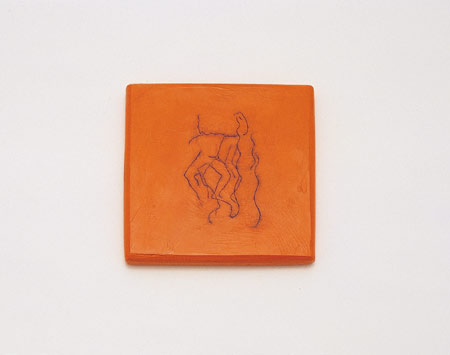![]()
2 |
|
addo ludovico trinci

![]()
 Angel
on the right, 2003
Angel
on the right, 2003
parafin on canvas
40 x 40 cm
Angelo destro,
2003
paraffina su tela
cm. 40 x 40
![]()
 Exhibitions
(selection)
Exhibitions
(selection)
Trinci participated in the following group and individual exhibitions
between 1992 and 1998:
Documenta IX, in Kassel, Museum Ottoneum, Museum Fridericianum,
Omaggio
a Primo Conti (Homage to Primo Conti) in the artist’s studio,
Della vita e dell’amore,Castel S. Pietro Terme; Suiraggi, Inerstudio
Ingegneri e Architetti,
In 1999: Daniela De Lorenzo e Addo Ludovico Trinci, Galleria e/static,
Turin,
and the exhibitions Lavori diversi 1 andLavori diversi 2 were held at
the same gallery.
LA
VOIX QUI VIENT
DE L’EST,
ENTRE
PAR L’OREILLE
DROITE
ET ENSEIGNE UN CHANT.
LA
VOCE CHE VIENE
DA EST,
ENTRA DALL’ORECCHIO
DESTRO
E INSEGNA UN CANTO.
33° NOME DI DIO
M.Y.
(Addo Ludovico Trinci)
(A
VOICE THAT COMES / FROM THE EAST, / ENTERS THE RIGHT / EAR / AND TEACHES
A SONG. /
33RD NAME OF GOD / M.Y.)
The text, written by the artist, is a reference to the work Angel on the right. The entire work reverberates from the fascination of the words. The narration has an antique, ancestral feel, something that has not been experienced, but remains constant in our intellectual awareness, however.
The work evokes in us the emotional atmosphere of intellectual ideals, the enchantment of the mind that is seeking the immateriality of the spiritual essence in the world – those eternal values that reawaken the perception of time and life.
The use of eastern mythology, or of any other divine figure, is a reference to an introspective dialogue that flows through man as a physical vehicle and, using his intellect, interrogates his surroundings as far as his vision can reach, and therefore to the limits of his being.
Simply perceiving this enables one to listen to the inanimate, to noiseless things, nature, the east wind, in the sense of an event as it is from there that we see the sun rise on the days of spring and autumn equinox.
That things awaken and sweep away all falsities can only be perceived if one is capable of capturing their imperceptable murmur.
The second work illustrates the final point of the first discourse, it completes the pattern in a way that is quite silent, as occurs in states of fulfillment, or the discovery of new awareness." Engraving on paraffin of a detail of the artist's studio. Listening on the other side with equanimity.” (Addo Lodovico Trinci)
Addo Ludovico Trinci was born in 1956 in Pistoia where he still lives and works.



LA
VOIX QUI VIENT
DE L’EST,
ENTRE PAR L’OREILLE
DROITE
ET ENSEIGNE UN CHANT.
LA
VOCE CHE VIENE
DA EST,
ENTRA DALL’ORECCHIO
DESTRO
E INSEGNA UN CANTO.
33°
NOME DI DIO
M.Y.
(Addo Ludovico Trinci)
Il testo scritto dall’artista è in riferimento al lavoro Angelo destro. L’intera opera risente della suggestione di queste parole. La narrazione ha un sapore antico, ancestrale, di un non vissuto che rimane però costante della nostra esperienza intellettiva.
Il lavoro rievoca in noi la suggestione emozionale di archetipi cognitivi, l’incanto dell’animo alla riscoperta animistica dell’essenziale spirituale del mondo, come valori eterni che ridestano la percezione del tempo e del vivere.
L’uso della mitologia orientale, o di qualsiasi altra figura divina, è in riferimento ad un dialogo introspettivo, che passa dall’uomo, come veicolo fisico, e attraverso il suo intelletto interroga ciò che lo circonda, fino ai limiti massimi della sua visibilità, e quindi del suo essere umano.
La sola percezione di tutto ciò consente di ascoltare l’inanimato ed il senza suono, la natura, il vento dell’est, nella sua accezione di accadimento, poiché in questa direzione si vede sorgere il sole nei giorni degli equinozi di primavera e di autunno.
Il risveglio delle cose, che soffia via ogni falsa conoscenza, è percepibile solo se si è in grado di ascoltarne l’impercettibile sussurro.
Il secondo lavoro descrive il punto ultimo del discorrere del primo, ne completa la sintassi, in una dimensione sempre silente, come in ogni stato di pienezza, di scoperta di consapevolezze nuove. “Incisione su paraffina di un particolare dello studio dell’artista. Dall’altra parte in ascolto con equanimità.” (Addo Lodovico Trinci)
Addo Ludovico Trinci nasce a Pistoia nel 1956, dove tutt’ora vive e lavora.
